SOLUTIONS
© Elsevier 2015
Sarah L. Harris and David Money HarrisDigital Design and Computer Architecture: ARM Edition�
CHAPTER 1
S O L U T I O N S
1
Exercise 1.1
(a) Biologists study cells at many levels. The cells are built from organelles
such as the mitochondria, ribosomes, and chloroplasts. Organelles are built of
macromolecules such as proteins, lipids, nucleic acids, and carbohydrates.
These biochemical macromolecules are built simpler molecules such as carbon
chains and amino acids. When studying at one of these levels of abstraction, bi-
ologists are usually interested in the levels above and below: what the structures
at that level are used to build, and how the structures themselves are built.
(b) The fundamental building blocks of chemistry are electrons, protons,
and neutrons (physicists are interested in how the protons and neutrons are
built). These blocks combine to form atoms. Atoms combine to form molecules.
For example, when chemists study molecules, they can abstract away the lower
levels of detail so that they can describe the general properties of a molecule
such as benzene without having to calculate the motion of the individual elec-
trons in the molecule.
Exercise 1.2
(a) Automobile designers use hierarchy to construct a car from major as-
semblies such as the engine, body, and suspension. The assemblies are con-
structed from subassemblies; for example, the engine contains cylinders, fuel
injectors, the ignition system, and the drive shaft. Modularity allows compo-
nents to be swapped without redesigning the rest of the car; for example, the
seats can be cloth, leather, or leather with a built in heater depending on the
model of the vehicle, so long as they all mount to the body in the same place.
Regularity involves the use of interchangeable parts and the sharing of parts be-
tween different vehicles; a 65R14 tire can be used on many different cars.
Sarah L. Harris and David Money HarrisDigital Design and Computer Architecture: ARM Edition© 2015 Elsevier, Inc.�
2
S O L U T I O N S
c h a p t e r 1
(b) Businesses use hierarchy in their organization chart. An employee re-
ports to a manager, who reports to a general manager who reports to a vice pres-
ident who reports to the president. Modularity includes well-defined interfaces
between divisions. The salesperson who spills a coke in his laptop calls a single
number for technical support and does not need to know the detailed organiza-
tion of the information systems department. Regularity includes the use of stan-
dard procedures. Accountants follow a well-defined set of rules to calculate
profit and loss so that the finances of each division can be combined to deter-
mine the finances of the company and so that the finances of the company can
be reported to investors who can make a straightforward comparison with other
companies.
Exercise 1.3
Ben can use a hierarchy to design the house. First, he can decide how many
bedrooms, bathrooms, kitchens, and other rooms he would like. He can then
jump up a level of hierarchy to decide the overall layout and dimensions of the
house. At the top-level of the hierarchy, he material he would like to use, what
kind of roof, etc. He can then jump to an even lower level of hierarchy to decide
the specific layout of each room, where he would like to place the doors, win-
dows, etc. He can use the principle of regularity in planning the framing of the
house. By using the same type of material, he can scale the framing depending
on the dimensions of each room. He can also use regularity to choose the same
(or a small set of) doors and windows for each room. That way, when he places
a new door or window he need not redesign the size, material, layout specifica-
tions from scratch. This is also an example of modularity: once he has designed
the specifications for the windows in one room, for example, he need not re-
specify them when he uses the same windows in another room. This will save
him both design time and, thus, money. He could also save by buying some
items (like windows) in bulk.
Exercise 1.4
An accuracy of +/- 50 mV indicates that the signal can be resolved to 100
mV intervals. There are 50 such intervals in the range of 0-5 volts, so the signal
represents log250 = 5.64 bits of information.
Exercise 1.5
(a) The hour hand can be resolved to 12 * 4 = 48 positions, which represents
log248 = 5.58 bits of information. (b) Knowing whether it is before or after noon
adds one more bit.
© 2015 Elsevier, Inc.�
S O L U T I O N S
3
Exercise 1.6
Each digit conveys log260 = 5.91 bits of information. 400010 = 1 6 4060 (1
in the 3600 column, 6 in the 60’s column, and 40 in the 1’s column).
Exercise 1.7
216 = 65,536 numbers.
Exercise 1.8
232-1 = 4,294,967,295
Exercise 1.9
(a) 216-1 = 65535; (b) 215-1 = 32767; (c) 215-1 = 32767
Exercise 1.10
(a) 232-1 = 4,294,967,295; (b) 231-1 = 2,147,483,647; (c) 231-1 =
2,147,483,647
Exercise 1.11
(a) 0; (b) -215 = -32768; (c) -(215-1) = -32767
Exercise 1.12
(a) 0; (b) -231 = -2,147,483,648; (c) -(231-1) = -2,147,483,647;
Exercise 1.13
(a) 10; (b) 54; (c) 240; (d) 2215
Exercise 1.14
(a) 14; (b) 36; (c) 215; (d) 15,012
Exercise 1.15
(a) A; (b) 36; (c) F0; (d) 8A7
Sarah L. Harris and David Money HarrisDigital Design and Computer Architecture: ARM Edition© 2015 Elsevier, Inc.�
4
S O L U T I O N S
c h a p t e r 1
Exercise 1.16
(a) E; (b) 24; (c) D7; (d) 3AA4
Exercise 1.17
(a) 165; (b) 59; (c) 65535; (d) 3489660928
Exercise 1.18
(a) 78; (b) 124; (c) 60,730; (d) 1,077,915, 649
Exercise 1.19
(a) 10100101; (b) 00111011; (c) 1111111111111111;
(d) 11010000000000000000000000000000
Exercise 1.20
(a) 1001110; (b) 1111100; (c) 1110110100111010; (d) 100 0000 0011
1111 1011 0000 0000 0001
Exercise 1.21
(a) -6; (b) -10; (c) 112; (d) -97
Exercise 1.22
(a) -2 (-8+4+2 = -2 or magnitude = 0001+1 = 0010: thus, -2); (b) -29 (-32
+ 2 + 1 = -29 or magnitude = 011100+1 = 011101: thus, -29); (c) 78; (d) -75
Exercise 1.23
(a) -2; (b) -22; (c) 112; (d) -31
Exercise 1.24
(a) -6; (b) -3; (c) 78; (d) -53
Exercise 1.25
(a) 101010; (b) 111111; (c) 11100101; (d) 1101001101
© 2015 Elsevier, Inc.�
S O L U T I O N S
5
Exercise 1.26
(a) 1110; (b) 110100; (c) 101010011; (d) 1011000111
Exercise 1.27
(a) 2A; (b) 3F; (c) E5; (d) 34D
Exercise 1.28
(a) E; (b) 34; (c) 153; (d) 2C7;
Exercise 1.29
(a) 00101010; (b) 11000001; (c) 01111100; (d) 10000000; (e) overflow
Exercise 1.30
(a) 00011000; (b) 11000101; (c) overflow; (d) overflow; (e) 01111111\
Exercise 1.31
00101010; (b) 10111111; (c) 01111100; (d) overflow; (e) overflow
Exercise 1.32
(a) 00011000; (b) 10111011; (c) overflow; (d) overflow; (e) 01111111
Exercise 1.33
(a) 00000101; (b) 11111010
Exercise 1.34
(a) 00000111; (b) 11111001
Exercise 1.35
(a) 00000101; (b) 00001010
Exercise 1.36
(a) 00000111; (b) 00001001
Exercise 1.37
Sarah L. Harris and David Money HarrisDigital Design and Computer Architecture: ARM Edition© 2015 Elsevier, Inc.�
6
S O L U T I O N S
c h a p t e r 1
(a) 52; (b) 77; (c) 345; (d) 1515
Exercise 1.38
(a) 0o16; (b) 0o64; (c) 0o339; (d) 0o1307
Exercise 1.39
(a) 1000102, 2216, 3410; (b) 1100112, 3316, 5110; (c) 0101011012, AD16,
17310; (d) 0110001001112, 62716, 157510
Exercise 1.40
(a) 0b10011; 0x13; 19; (b) 0b100101; 0x25; 37; (c) 0b11111001; 0xF9;
249; (d) 0b10101110000; 0x570; 1392
Exercise 1.41
15 greater than 0, 16 less than 0; 15 greater and 15 less for sign/magnitude
Exercise 1.42
(26-1) are greater than 0; 26 are less than 0. For sign/magnitude numbers,
(26-1) are still greater than 0, but (26-1) are less than 0.
Exercise 1.43
4, 8
Exercise 1.44
8
Exercise 1.45
5,760,000
Exercise 1.46
(5 × 109 bits/second)(60 seconds/minute)(1 byte/8 bits) = 3.75 × 1010
bytes
Exercise 1.47
46.566 gigabytes
© 2015 Elsevier, Inc.�
S O L U T I O N S
7
Exercise 1.48
2 billion
Exercise 1.49
128 kbits
Exercise 1.50
-4
-3
-2
-1
0
1
2
3
4
5
6
7
Unsigned
000
001
010
011
100
101
110
111
100
101
110
111
000
001
010
011
Two's Complement
111
110
101
000
100
001
010
011
Sign/Magnitude
Exercise 1.51
-2
-1
0
1
2
3
Unsigned
00
01
10
11
10
11
00
01
Two's Complement
11
00
10
01
Sign/Magnitude
Exercise 1.52
(a) 1101; (b) 11000 (overflows)
Exercise 1.53
Sarah L. Harris and David Money HarrisDigital Design and Computer Architecture: ARM Edition© 2015 Elsevier, Inc.�
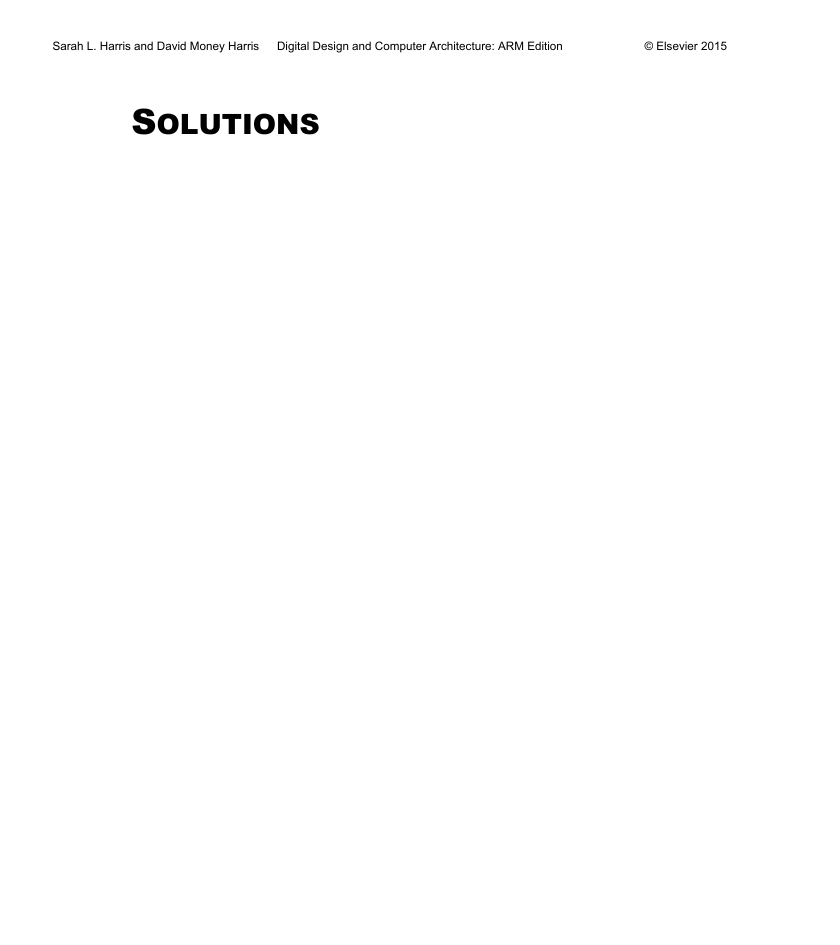
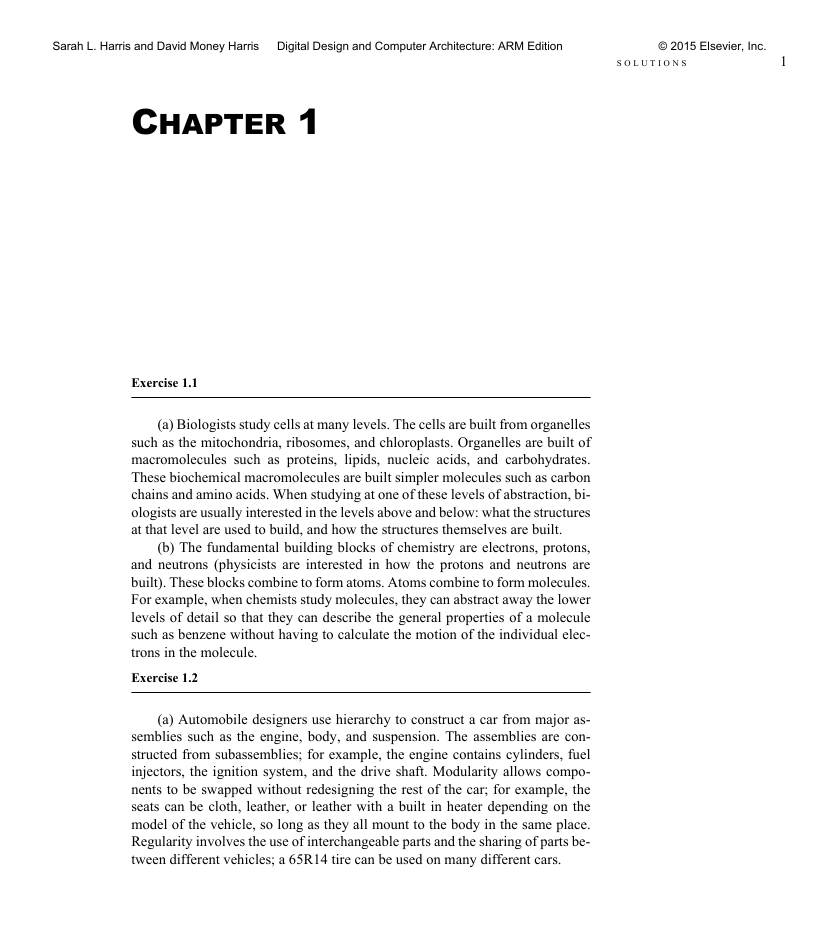
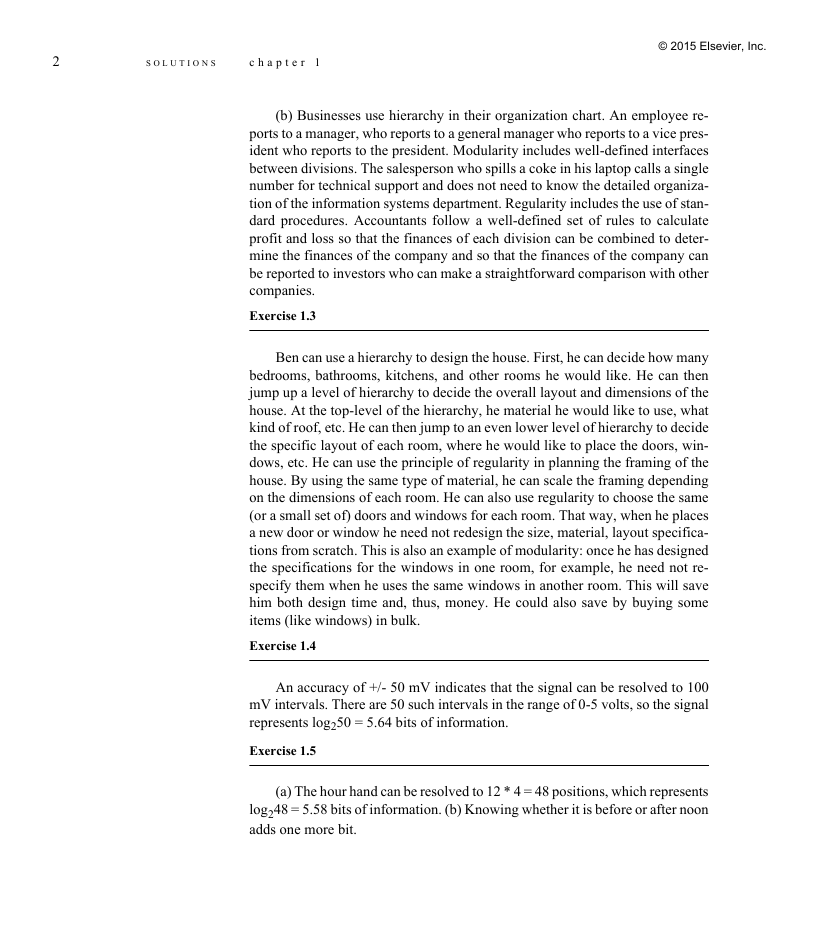
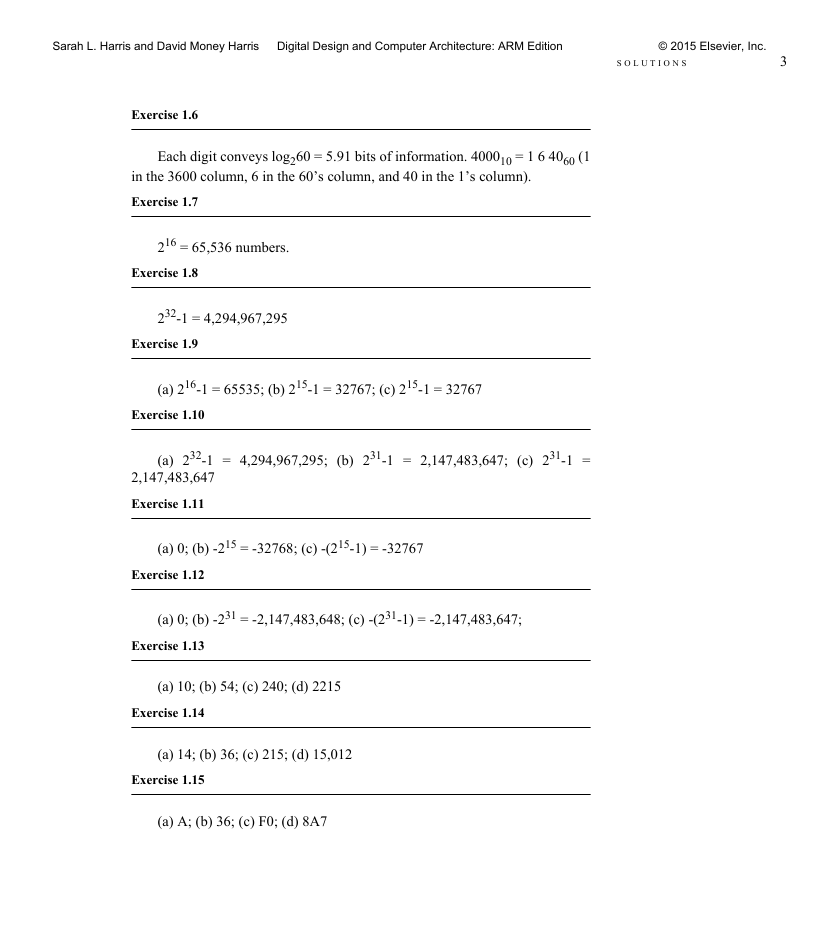
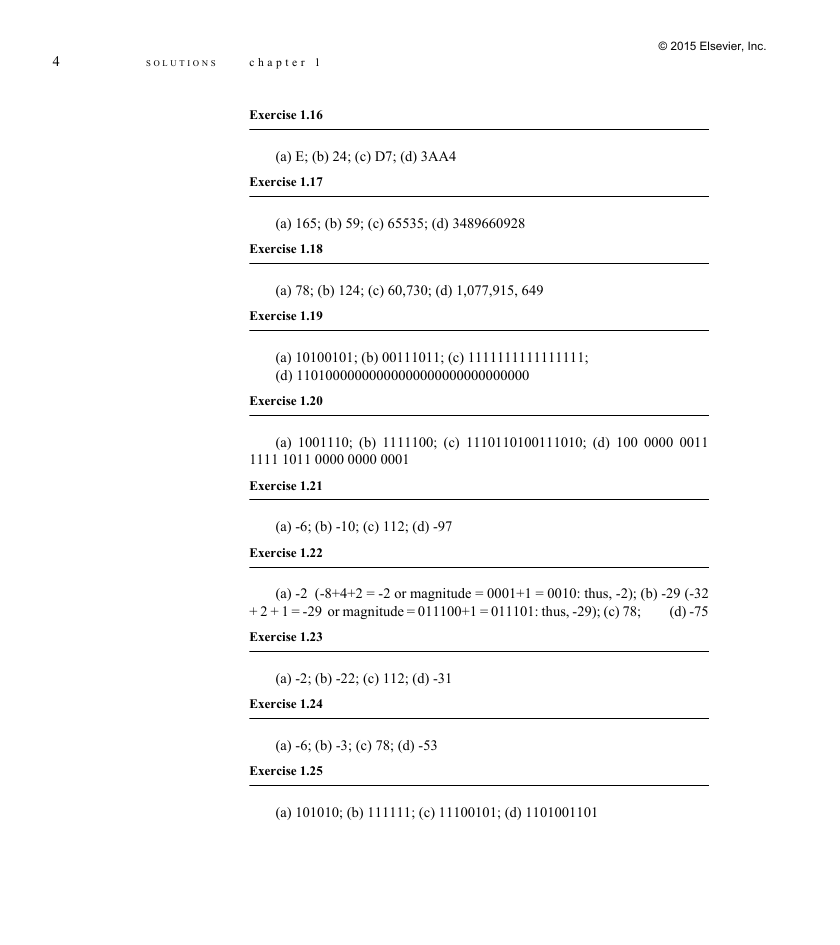
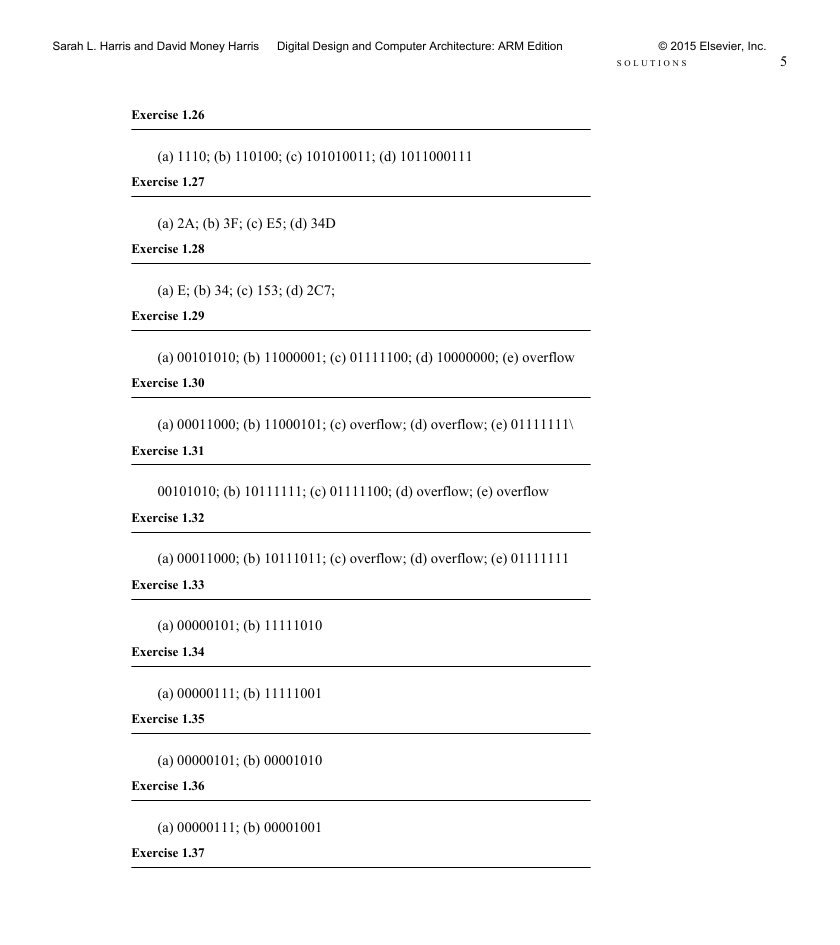
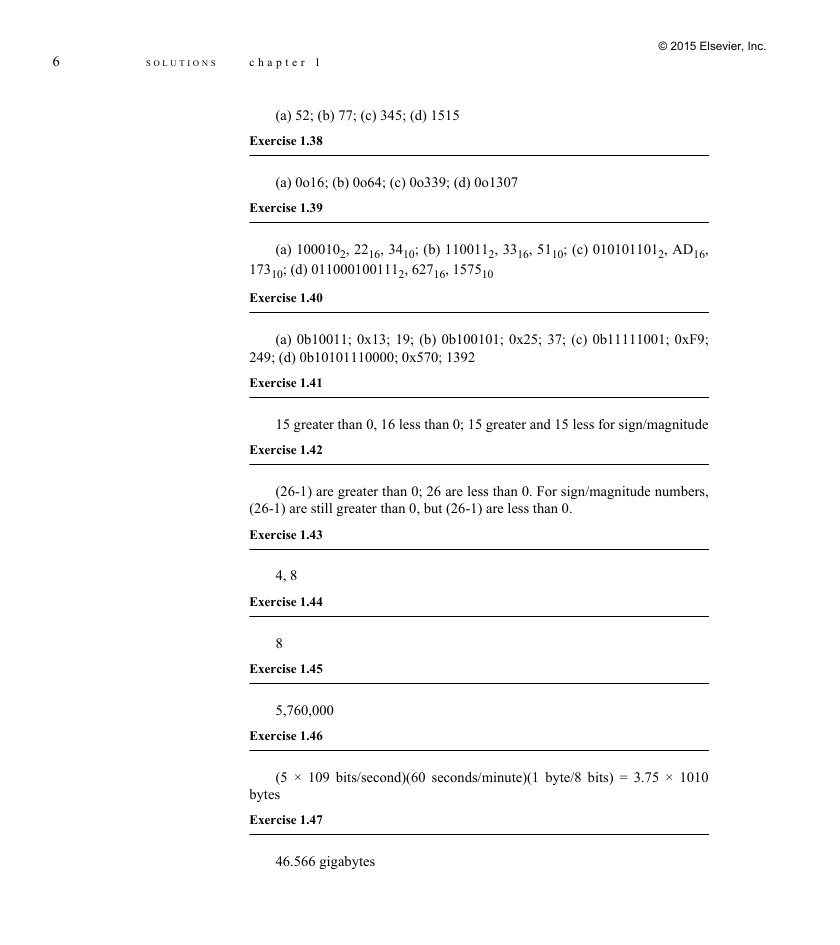
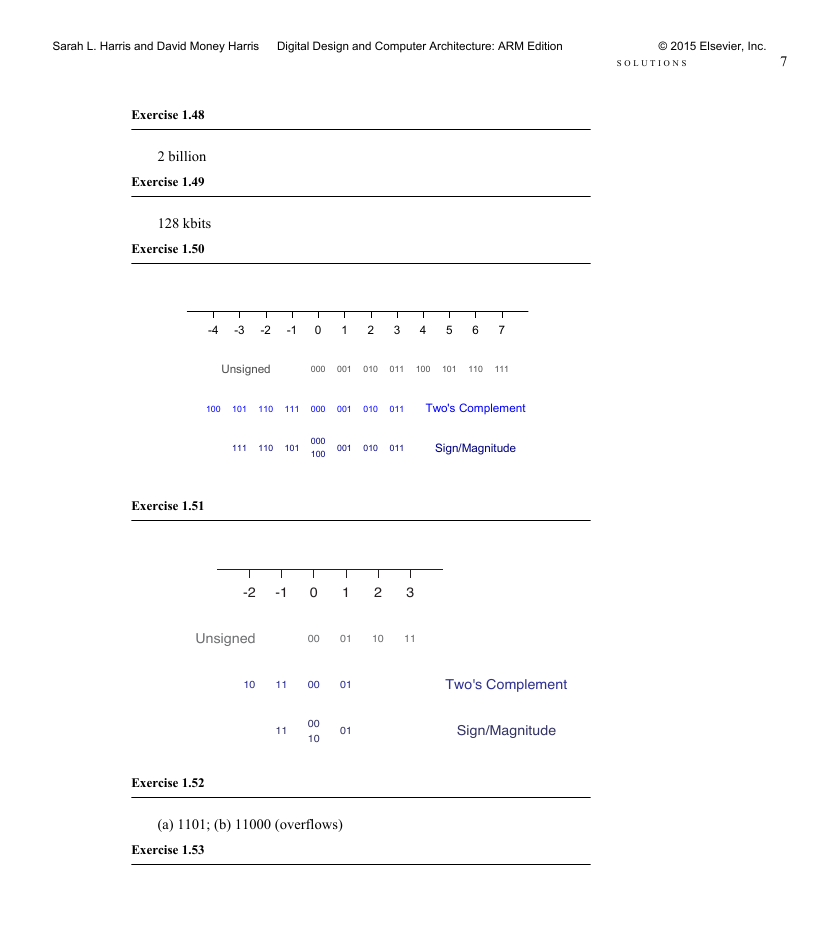








 2023年江西萍乡中考道德与法治真题及答案.doc
2023年江西萍乡中考道德与法治真题及答案.doc 2012年重庆南川中考生物真题及答案.doc
2012年重庆南川中考生物真题及答案.doc 2013年江西师范大学地理学综合及文艺理论基础考研真题.doc
2013年江西师范大学地理学综合及文艺理论基础考研真题.doc 2020年四川甘孜小升初语文真题及答案I卷.doc
2020年四川甘孜小升初语文真题及答案I卷.doc 2020年注册岩土工程师专业基础考试真题及答案.doc
2020年注册岩土工程师专业基础考试真题及答案.doc 2023-2024学年福建省厦门市九年级上学期数学月考试题及答案.doc
2023-2024学年福建省厦门市九年级上学期数学月考试题及答案.doc 2021-2022学年辽宁省沈阳市大东区九年级上学期语文期末试题及答案.doc
2021-2022学年辽宁省沈阳市大东区九年级上学期语文期末试题及答案.doc 2022-2023学年北京东城区初三第一学期物理期末试卷及答案.doc
2022-2023学年北京东城区初三第一学期物理期末试卷及答案.doc 2018上半年江西教师资格初中地理学科知识与教学能力真题及答案.doc
2018上半年江西教师资格初中地理学科知识与教学能力真题及答案.doc 2012年河北国家公务员申论考试真题及答案-省级.doc
2012年河北国家公务员申论考试真题及答案-省级.doc 2020-2021学年江苏省扬州市江都区邵樊片九年级上学期数学第一次质量检测试题及答案.doc
2020-2021学年江苏省扬州市江都区邵樊片九年级上学期数学第一次质量检测试题及答案.doc 2022下半年黑龙江教师资格证中学综合素质真题及答案.doc
2022下半年黑龙江教师资格证中学综合素质真题及答案.doc